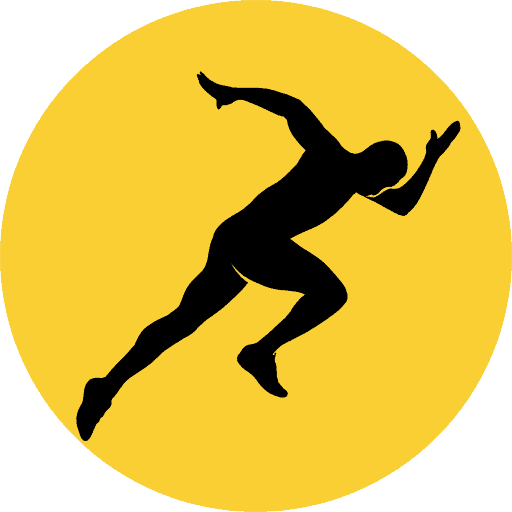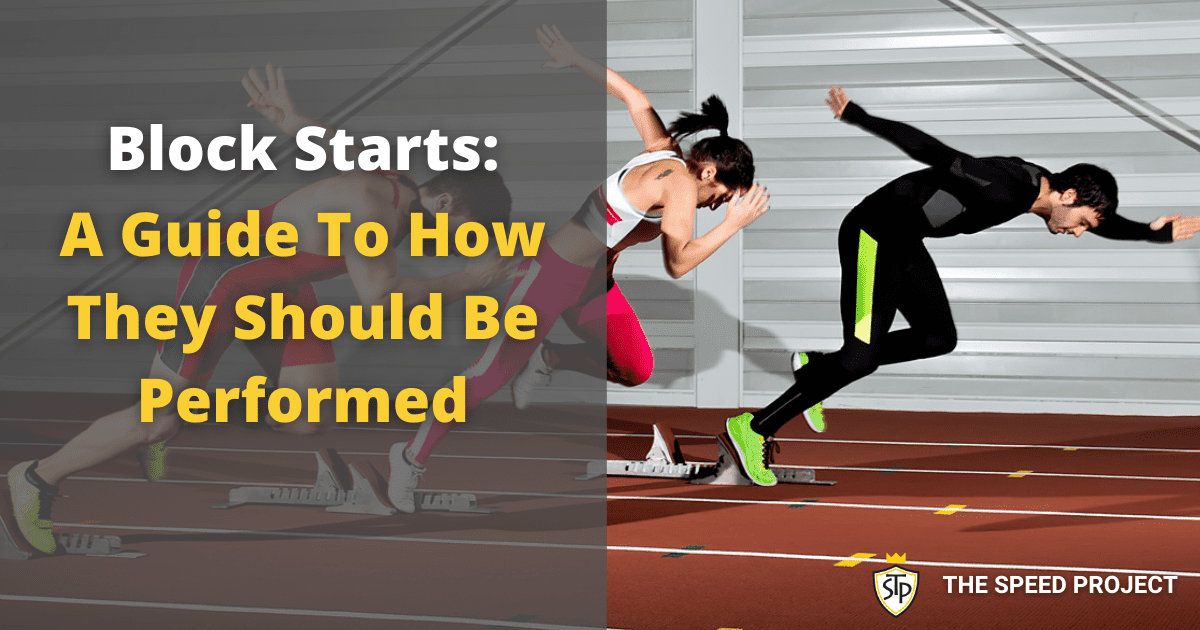We all know that sprint events can be won or lost by the smallest of margins. Every millisecond counts! This is why athletes spend so much time trying to perfect all aspects of their race.
Block starts are arguably the most important aspect. Fail here and you could be instantly out of the race. However, athletes with the best reaction time, greatest power, and ability to accelerate most rapidly will excel.
Therefore, an athlete who can execute a great sprint start may be able to win a race even if he or she is not the fastest athlete in the field.
Why Proper Block Start Execution is so Important
An athlete with a super quick start leaves the blocks first and therefore begins accelerating first. They are then able to reach their top speed before the other athletes.
So although their top speed may not be as fast as another competitor, they could still cross the finish line first. This is because they are able to reach their top speed sooner.
In an event where the difference between winning gold or falling outside of the medals is minuscule, the margin for error is extremely small.
Let me give you a practical example…
The 2017 World Championships in London. Sprint legend and fan favourite Usain Bolt finished 3rd in the final of the men’s 100m.
Interestingly, Bolt actually covered the distance quicker than any of his opponents. Yet, he had the second-worst reaction time to the gun with a reaction of 0.183.
This was significantly slower than Coleman’s (0.123) and Gatlin’s (0.138). In the end, Bolt just had too much work to do to catch them.
| POS | ATHLETE | COUNTRY | MARK | REACTION TIME |
| 1 | Justin GATLIN | USA | 9.92 SB | 0.138 |
| 2 | Christian COLEMAN | USA | 9.94 | 0.123 |
| 3 | Usain BOLT | JAM | 9.95 SB | 0.183 |
| 4 | Yohan BLAKE | JAM | 9.99 | 0.137 |
| 5 | Akani SIMBINE | RSA | 10.01 | 0.141 |
| 6 | Jimmy VICAUT | FRA | 10.08 | 0.152 |
| 7 | Reece PRESCOD | GBR | 10.17 | 0.145 |
| 8 | Bingtian SU | CHN | 10.27 | 0.224 |
IAAF WORLD CHAMPIONSHIPS LONDON 2017 – Men’s 100 metres final results
So the importance of a good sprint start can’t be stressed enough. Obviously, it is not the only aspect of a race but a good a start could potentially make all the difference.
Different Types of Sprint Start Techniques
There are actually a few different starting techniques that you can use. Usually, in competition, you will be accelerating out of the blocks but this is not always the case when you are training.
We use a variation of sprint start techniques in our training which are often based on the percentage at which we are working. We use blocks during high-intensity training, work at maximum effort, or simply when practising starts.
The other types of starts include the 2 point standing start, the 3 point start and the 4 point start (without blocks).
How to Perform a 2 Point Standing Start
Here are the cues for the 2 point start:
- From the “on your marks” call, place your front foot just behind the starting line.
- Keep feet shoulder-width/just within shoulder-width apart (wherever you feel the most balanced) and split the feet.
- At the “set” position, bend at the hips whilst maintaining a neutral spine/head and shift your weight onto your front foot.
- Split the arms so that they are opposite to your feet placement.
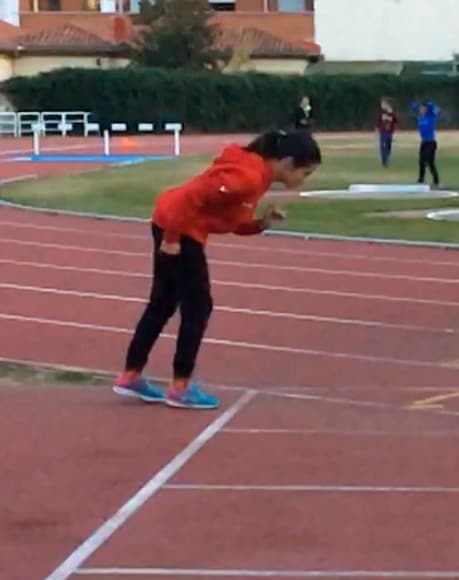
How to Perform a 3 Point Start
You may have seen athletes using a 3 point start in other sports. For example, athletes adopt a 3 point start in American football and baseball when performing the 40 or 60-yard dash.
Here are the cues for the 3 point start:
- Use your feet to measure about 2 feet spaces from the start line.
- Place your strong leg forward and your quick leg behind (I’ll show you how to determine this).
- Kneel down so that your back leg/knee is on the ground. The knee of your back leg should be in front of your front foot.
- Alternate your arms with your feet. So if your left foot was forward then you would place your right hand before the start line.
- The other hand is placed to the side of your body.
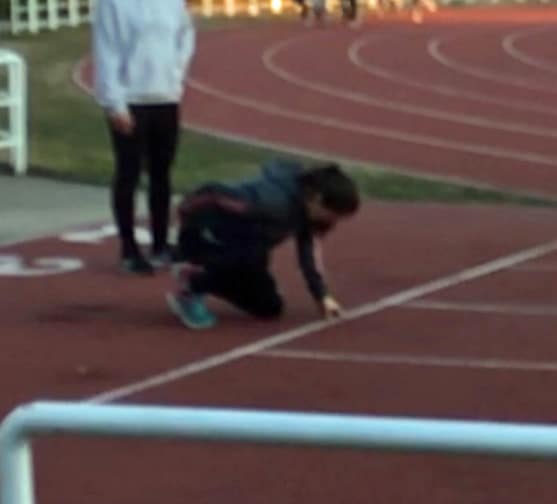
- On the “set” call, raise your hips so that your back leg forms about a 120-degree angle and slightly raise the loose arm behind you. You may wish to extend at the elbow.
- Don’t shift your weight from your legs or put pressure on the holding arm as you will be off-balanced.
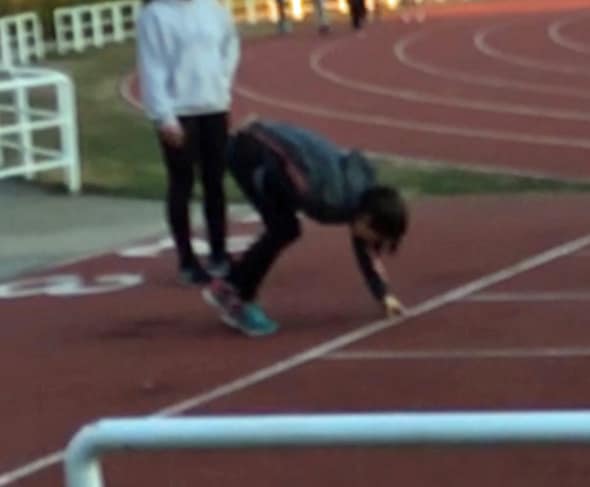
How to Perform a 4 Point Start Without Blocks
Continuing our instructions from the 3 point start, here are the cues for the 4 point start without blocks:
- Same steps as the 3 point start but now place both hands before the starting line so that you are balanced.
- Place fingers before the line and form a slight bridge with the hands.
- Keep hands slightly wider than shoulder-width.
- Keep the arms straight but not fully locked out.
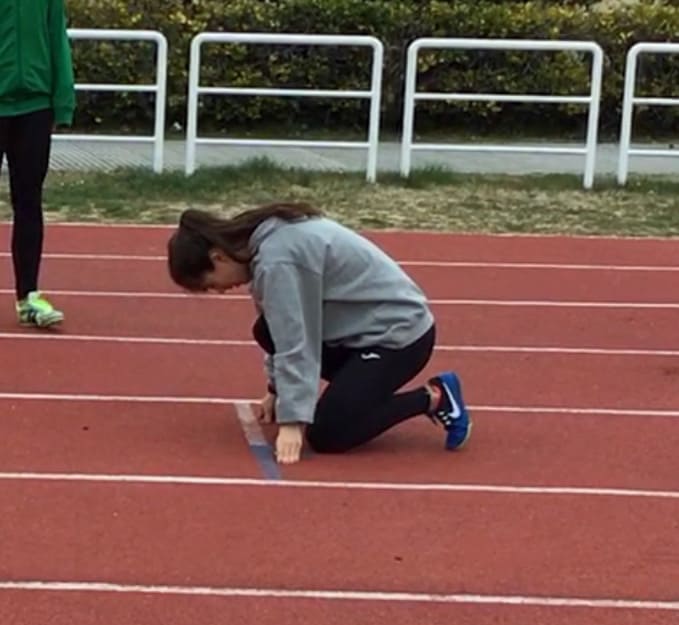
- When “set” is called, raise your hips so that your back leg forms about a 120-degree angle.
- Don’t lean too far forward over the line as you don’t want the majority of your weight transferred to your hands.
- Hold until “go.”
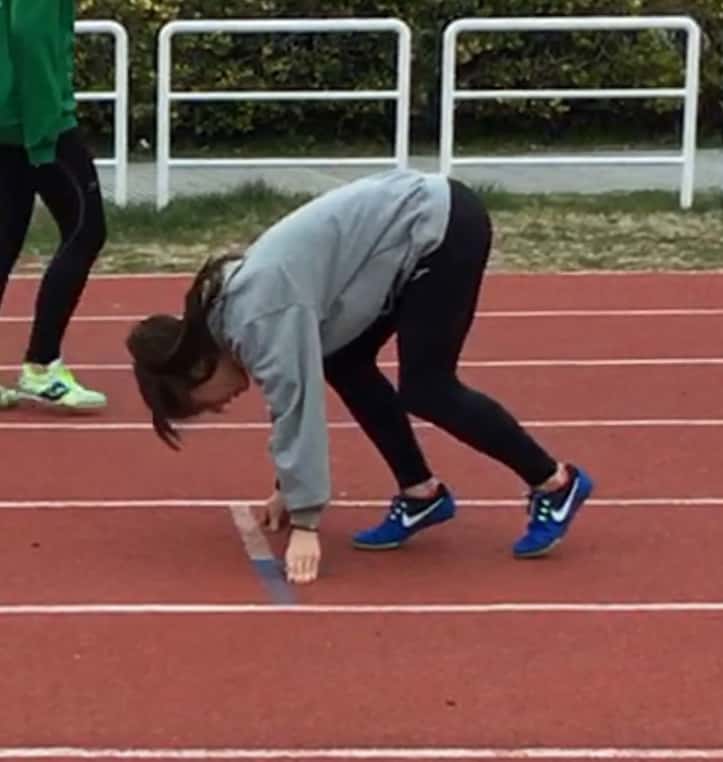
Block Starts
The block start is used in all the sprint events and is the most technically challenging type of start that you can do. The shorter the distance, the more important it is to be explosive out of the blocks.
Note: More powerful sprinters may be better suited to running shorter sprints. The power obtained for an explosive start is often a trade-off for maintenance of maximum velocity. Dwain Chambers comes to mind as an extremely good 60m runner due to his power and explosiveness. But he failed to challenge the worlds elite over the 100m.
How to Determine Which Foot Goes in the Front Pedal?
Not every sprinter starts with the same foot in the front pedal. To determine your feet positions, go through a process of trial and error.
Run a series of timed accelerations over 10-30m, switching your feet position in the pedals. From here you can check your times and determine which placement feels most comfortable.
Ultimately I leave it down to the athlete to determine which position they feel most comfortable with. But if there is a significant time difference between leading legs, then it makes sense to go with what produces faster times.
If you are just starting out, here’s an easy tip. Stand with your back to someone and have them push you lightly in the back. Not excessively, but enough to make you move forward.
The leg that you put out to stop yourself from falling is the leg that will go in the back pedal. This is the leg that comes away first during your start from the blocks.
You can always make adjustments to your block positions if you feel they can be improved.
Note: Make sure that any adjustments are always made during training. Never trial something new at a competition as there is a higher risk of something going wrong and under-performing as a result.
How to Set-Up Your Starting Blocks
After determining which foot will be in which pedal you’ll be ready to set up your blocks.
Use two feet lengths from the start line to determine the position of the first pedal and three feet from the line to determine the second pedal. As a guideline, use a 45-degree angle for the first pedal and 55 degrees for the second.
This is the block set up for running the 100m. If you are running the 200m or 400m then you can use the same process but make sure you place the blocks at a tangent to the curve.
There is no rule as to the exact spacing of the pedals but this is a great guideline that allows for good positioning.
Make sure the blocks are firmly located into the track as you don’t want them to move once you push off the pedals during the race.
Note: If your feet are too far away from the start line then you will struggle to generate power. And if your feet are too close, you’re likely to stumble onto your face! So if in doubt, use the guidelines suggested.
Hand Placement
It’s important that your hands are placed as close to, but behind the line. The width of your hands again will be determined by where you feel most comfortable.
Some athletes prefer just outside shoulder width (which I would suggest). Other athletes who are perhaps more powerful, choose to go even wider so they can get their bodies lower to the ground and generate more power. You have to be extremely strong to execute this effectively.
Tip: For good hand placement, create an invisible line from your thumb to your shoulder.
Also, you don’t want to have your hands too close together. Definitely not inside shoulder width. This will make you sit in a high position during “set”, which makes it more difficult for you to explode from the blocks. You also don’t want your arms to collide with your legs!
Reacting to the Starters Gun
It’s important to develop your reaction time to get off to a flying start. You need to make sure that you react ONLY to the gun. In most competitions, it’s one false start and you’re out!
Wait for the ‘B’ of the bang and launch yourself out of the blocks, pushing off the pedals with both feet whilst pumping the arms rapidly.
It’s important that you begin aggressively. Failing to do so will reduce your speed during your drive phase of the race.
During training, it’s a good idea to have your coach or someone call the command out for you when practising your sprint starts.
You can go by voice alone but it’s better to have someone clap or use a tool to imitate the bang. This will be closer to what you will experience in competition.
Note: I like to give my athletes a forfeit if they false start during training. A round of push-ups or an extra set works well.
How to Perform a Block Start
To get into position, crouch down and slowly back yourself into the blocks. Continue until your feet are positioned where you want them on the pedals and position your hands at the line.
Get comfortable in the blocks and imagine yourself as a coiled spring that’s ready to pop!
During Competition
It’s vital that you go through the same routine and set up each and every time you use your blocks in competition. Your blocks routine should become second nature.
Once your blocks are set up how you want them and you’ve made sure that they are securely pressed into the track, have a few practice accelerations. Accelerate for 10-20m.
Go through your routine which will allow you to clear your mind and focus solely on the race. I get my athletes to picture themselves running the perfect race before they get in the blocks. Any kind of positive imagery can help.
Useful Info: In a competition, if you are unhappy with any conditions after the “on your marks call,” you can raise your hand and stop the race.
This must be done before the announcer says “set.” If you move after this command, you will be disqualified.
Make sure that your reason is valid. If the official deems your reason to be invalid then you will be issued with a yellow card. Two yellow cards also lead to disqualification.
During the set call, take a deep breath in and bring the hips up into a loaded position. Don’t come up too high with the back leg otherwise, you will not be able to generate as much power.
Drive forward for the first 10m. From 10-30m you should gradually begin to come up into an upright position. Here you should be nearing full flow and approaching maximum velocity.
The distances of the drive phase can vary depending on how quickly and powerfully you can accelerate.
Follow the information in this guide, apply time and effort in training and you’ll improve your block starts!
